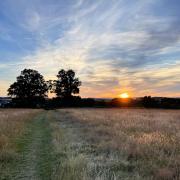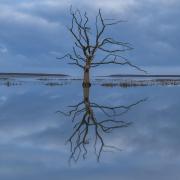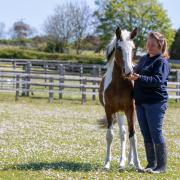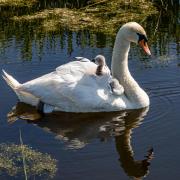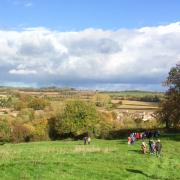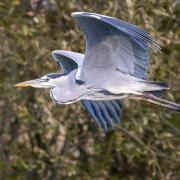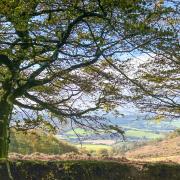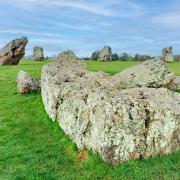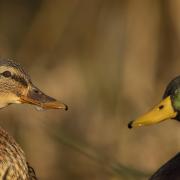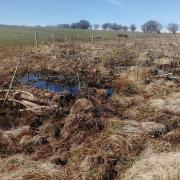‘Natural navigation is the most beautiful, subtle and underrated art in the world. We are all navigators and yet we give it little thought and hardly any credit at all.’ I am fortunate enough to be standing in my wellies, out on a walk in Somerset, with international best-selling author, and explorer, Tristan Gooley.
Renowned for his burgeoning bibliography of navigational titles, Tristan’s previous books have looked in-depth at the secret worlds of our weather and water systems, and now, this year he is taking us on a new journey with his latest book, How to read a tree.
Completely on brand, Tristan has arrived in his Land Rover Defender and is kitted out in what has become his recognisable uniform of outdoor gear, complete with leather country boots and Fedora hat. Before his canvas rucksack is even slung on his shoulder, he’s stopping us in our tracks and is pointing to the very large Lombardy poplar tree which is stretching its limbs to the sky. ‘These trees are often planted in a line to mark the edge of a property or farm. They are easy to recognise and our ancestors would have used them as a clue to know that they were approaching civilisation. The Lombardy is a member of the water-loving poplar family, so this is a double clue, we must be near to water.’ As we turn the corner to head up a farm track and immediately splash through the run-off from a natural spring, it is dawning on me that despite being a self-professed ‘country-girl’, I have a lot to learn, and so I immediately open up my notebook!

Tristan is quick to say that the art of reading of trees is in the learning of recognising their shapes and patterns, rather than their Latin names and species identification. After all, ‘there isn’t a soul on the planet who can identify most of the trees on Earth by sight’, plus many trees have many different names, so he recommends that we focus more on the global language of the natural signs the trees are giving us instead. ‘I love the idea that we can recognise patterns in nature that someone on the other side of the world would also know, even if we don’t speak a word of each other’s language!’
Before long, we are approaching an ancient old Chestnut tree, its trunk is so wide that it would take three adults all joining hands to circumvent. Tristan asks for a moment alone as he approaches the tree slowly, pausing as he studies signs and clues which I am yet even to be privy to. As an observer, I feel incredibly privileged to watch this celebrated natural navigator at work, and I’m also trying to keep my excitement in check. The suspense is thrilling, what will he discover, what can he read in this tree? As he casually walks back to survey the majestic Chestnut from a distanced vantage point, he explains how this tree has been something of a stalwart warrior.
The first sign he points out for me to read is that of ‘woundwood’. It turns out that whenever the bark of a tree suffers an injury, such as losing a limb, it quickly races to grow a protective layer which acts as a plaster on the wound. This ‘woundwood’ seals out the oxygen and aims to prevent any invaders from getting inside and feasting on the vulnerable tissues. The next sign to be read is that of a ‘Southern Eye’. ‘If a branch of a tree is no longer harvesting light (due to the branches above shading it) then the tree decides to shut that branch down, using gums or resins to form an inner seal. Once that branch is cut off from water and nutrients it will die, slowly falling prey to fungi before snapping off and leaving a stump which in turn rots away. These stumps very often have a curved line in the bark above them which resembles an eyebrow, creating an ‘eye’.’ The most fascinating learning for me, is that these eyes are all facing south so can then be used as a natural compass whilst out navigating!

I’m often out and about hiking our footpaths, and I wondered if there is any clue specific to Somerset which I could read in our trees without having to reach for my compass? With Somerset being illustrious for our cider-making I asked Tristan if there is any way we can use our apple trees to help navigate whilst walking locally? ‘One of the first and easiest signs to spot, which is applicable to all trees in the UK, is that trees will grow bigger on the southern side. If you’re then looking for confirmation in an apple tree, it’s worth remembering that more of the apples on the southern side of the tree will be rosy red before those on the northern side. If it’s earlier in the season, then the southern side will have more flower blossom.’
As we stroll into open parkland, we can see a line of trees in the horizon. ‘Trees always react to the wind. The trees on the windward side of any woodland will tend to grow less tall than the sheltered ones. I have nicknamed this the ‘wedge effect’. The easiest way to think of it is that the wedge shape can look like the bonnet of a car and we just need to remember that the car drives into the wind. From a natural navigational sense, this is towards the south-west in the UK. Similarly, if you’re by the coast you may spot asymmetrical tree tops with one side of the tree doing OK and the other side completely bare. I call this ‘flagging’ because the remaining branches are like flags, and will tend to point north-east.’

Our footpath leads us over a stile and we find ourselves tracking through a woodland. Tristan has spotted more and more clues and I am beginning to comprehend how there are hundreds of signs to read in our trees, and that my future dog walks and hikes across our county are certainly going to take longer than before. It’s an important realisation. All too often I navigate with a sense of urgency, covering a certain distance in a designated window of time, but amongst all the many learnings of my walk with Tristan today, what I have also realised is that there is more to enjoy than the obvious views which present themselves, there are also stories to read in the trees along the way. ‘I often get asked if we need natural navigation, if all you are trying to do is get from A to B, then no, of course not. However, what if you are trying to find fascination along the way? If you are looking for something of interest along your journey, something that adds a level of beauty, then natural navigation is absolutely vital.’

THE BOOK: HOW TO READ A TREE
Each tree we meet is filled with signs that reveal secrets about the life of that tree and the landscape we stand in.
The clues are easy to spot when you know what to look for, but remain invisible to most people.
In How to Read a Tree, you'll be able to discover the simple prinicples that explain the shapes and patterns you can see in trees and what they mean.
And you'll learn rare skills that can be applied every time you pass a tree, whether you are in a town or a wilder spot.
Tristan Gooley knows how to uncover the phenomena worth looking for and has been instructing people in the art of reading trees for two decades.
Once you have learned to see these, it is impossible to unsee them.
How to Read a Tree by Tristan Gooley is published by Sceptre and is available to buy in many bookshops.
This article was first published in the June 2023 issue of Somerset Life magazine, its texts and images are exclusively copyrighted to this publication ONLY.





